SEO
How to Build a Keyword Strategy [Free Template]
![How to Build a Keyword Strategy [Free Template] How to Build a Keyword Strategy [Free Template]](https://articles.entireweb.com/wp-content/uploads/2022/10/1665736515_How-to-Build-a-Keyword-Strategy-Free-Template.png)
Building a keyword strategy is the process of deciding what keywords to target and prioritize in organic search.
There are many ways to do it, but all methods pretty much boil down to finding keywords that:
- Potential customers are searching for.
- Have value for your business.
- Are within your wheelhouse to rank for.
![How to Build a Keyword Strategy [Free Template] The best keywords have traffic, business, and ranking potential](https://articles.entireweb.com/wp-content/uploads/2022/10/How-to-Build-a-Keyword-Strategy-Free-Template.png)
Let’s go through how to do this in four simple steps.
There’s no point in targeting keywords that nobody types into Google because they won’t send you traffic even if you rank #1. So the first step is to find keywords that potential customers are searching for.
Let’s look at a couple of ways to do this.
A. See which of your competitors’ pages get the most traffic
If your competitor gets a lot of organic traffic to a page, the keyword it’s targeting must have traffic potential. And because they’re a competitor, such keywords are probably ones your customers are searching for too.
Here’s how to find which of your competitors’ pages get the most search traffic:
- Go to Ahrefs’ Site Explorer
- Enter a competitor’s domain
- Go to the Top pages report
For example, if you are looking for keywords for an online computer parts store, you may enter newegg.com. In the report, you’ll see its top pages by estimated organic traffic and the keyword sending the most traffic to each page.
![How to Build a Keyword Strategy [Free Template] Top pages by estimated organic search traffic for newegg.com, via Ahrefs' Site Explorer](https://articles.entireweb.com/wp-content/uploads/2022/10/1665736513_88_How-to-Build-a-Keyword-Strategy-Free-Template.png)
Recommendation
![How to Build a Keyword Strategy [Free Template] Excluding branded keyword in the Organic keywords report in Site Explorer](https://articles.entireweb.com/wp-content/uploads/2022/10/1665736513_448_How-to-Build-a-Keyword-Strategy-Free-Template.png)
Make a note of any that your customers may also be searching for.
Here are a few for our hypothetical computer parts store:
![How to Build a Keyword Strategy [Free Template] Examples of keywords with traffic potential](https://articles.entireweb.com/wp-content/uploads/2022/10/1665736513_137_How-to-Build-a-Keyword-Strategy-Free-Template.png)
Note that we didn’t highlight “gaming desk” or “gaming pc” because our store sells computer parts, not accessories or ready-built computers. There’s no point in targeting these keywords, as the people searching for them aren’t our customers.
B. Use a keyword research tool
Keyword research tools are big keyword databases that you can search and filter.
Here’s how to use our keyword tool to find keywords with traffic potential:
- Go to Ahrefs’ Keywords Explorer
- Enter a few broad keywords related to your site (these are known as your “seeds”)
- Go to the Matching terms report
- Filter for keywords with Traffic Potential (TP)
For example, for a computer parts store, you can enter seed keywords like pc, computer, computers, motherboard, motherboards, amd, and intel. Then you’ll filter the Matching terms report for keywords with Traffic Potential.
![How to Build a Keyword Strategy [Free Template] Filtering for keywords with Traffic Potential in Ahrefs' Keywords Explorer](https://articles.entireweb.com/wp-content/uploads/2022/10/1665736513_615_How-to-Build-a-Keyword-Strategy-Free-Template.png)
Recommendation
Now it’s just a case of eyeballing the report for keywords potential customers are searching for.
![How to Build a Keyword Strategy [Free Template] Examples of keywords customers of a computer parts store would be searching for](https://articles.entireweb.com/wp-content/uploads/2022/10/1665736513_531_How-to-Build-a-Keyword-Strategy-Free-Template.png)
Each keyword your potential customers are searching for has some value for your business. But some have more value than others.
Take these three keywords, for example:
- “graphics card” – Searchers are shopping around. They’re nowhere near ready to buy.
- “b550 vs x570 motherboard” – Searchers have done some shopping around and narrowed down their options. They’re almost ready to buy.
- “amd ryzen 5 3600” – Searchers have decided what they want. They’re ready to buy.
Given that some of these searchers are closer to buying a computer part than others, some keywords arguably have more “business potential” for a computer parts store. These are the ones you should prioritize in your keyword strategy.
Here’s a quick cheat sheet for scoring the “business potential” of keywords:
![How to Build a Keyword Strategy [Free Template] How to score a keyword's business potential](https://articles.entireweb.com/wp-content/uploads/2022/10/1665736513_936_How-to-Build-a-Keyword-Strategy-Free-Template.png)
Sidenote.
This is based on the scoring system we came up with when assessing keywords for our blog. Read more about this in our guide to keyword research.
Just keep in mind that the way you score a keyword may differ from how someone else scores it. It depends on how valuable it is for your business. For example, if you don’t sell the “amd ryzen 5 3600,” that keyword has a “business potential” score of 0 for you—not 3.
Keywords vary in ranking difficulty for a number of reasons. This doesn’t mean you should avoid those that are harder to rank for than others, but it’s important to take ranking difficulty into account when building your keyword strategy.
Here are four things we recommend you look at to assess ranking difficulty:
Backlinks
Backlinks are one of Google’s top ranking factors. The more high-quality backlinks the current top-ranking pages have, the harder it’ll be to compete with them.
For a rough idea of how many backlinks you’ll need to crack the top 10, check the Keyword Difficulty (KD) score in Ahrefs’ Keywords Explorer. This is based on the number of links to the top-ranking pages.
![How to Build a Keyword Strategy [Free Template] Example of a keyword with medium keyword difficulty in Ahrefs' Keywords Explorer](https://articles.entireweb.com/wp-content/uploads/2022/10/1665736513_637_How-to-Build-a-Keyword-Strategy-Free-Template.png)
For a more thorough assessment, scroll to the SERP overview and check the “Domains” column to see the number of linking websites to each page.
![How to Build a Keyword Strategy [Free Template] Linking domains to the top-ranking pages for "micro atx case"](https://articles.entireweb.com/wp-content/uploads/2022/10/1665736514_537_How-to-Build-a-Keyword-Strategy-Free-Template.png)
Just keep in mind that these numbers only tell you the quantity of links to each page. To understand link quality, you’ll have to review each page’s backlink profile. You can get to this by clicking on the number in the “Backlinks” column.
![How to Build a Keyword Strategy [Free Template] Backlinks report for one of the top-ranking pages for "micro atx case," via Ahrefs' Site Explorer](https://articles.entireweb.com/wp-content/uploads/2022/10/1665736514_989_How-to-Build-a-Keyword-Strategy-Free-Template.png)
Learn more: How to Do a Basic Backlink Audit
Authority
Many SEOs believe that popular websites have an easier time ranking on Google. For that reason, most take a website authority metric like Domain Rating (DR) into account when assessing a keyword’s ranking difficulty.
Google representatives have said many times that Google doesn’t evaluate a site’s authority. But there are a couple of ways the so-called authority of a site could indirectly contribute to rankings.
- Internal links – High-DR sites tend to have more high-authority pages, and internal links from those pages may help other pages to rank higher.
- Familiar brands – Searchers likely want to see household names for some queries. If that’s not you, you may have a harder time ranking.
If you are in the camp that thinks Google takes site authority into account or just want to err on the safe side, check the top-ranking pages’ DR scores in Keywords Explorer. If they’re all much higher than your site’s DR, you may want to prioritize other keywords.
![How to Build a Keyword Strategy [Free Template] Domain Rating (DR) of the top-ranking sites for "3090 graphics card"](https://articles.entireweb.com/wp-content/uploads/2022/10/1665736514_666_How-to-Build-a-Keyword-Strategy-Free-Template.png)
Recommendation
![How to Build a Keyword Strategy [Free Template] Domain Rating (DR) in Ahrefs' Site Explorer](https://articles.entireweb.com/wp-content/uploads/2022/10/1665736514_15_How-to-Build-a-Keyword-Strategy-Free-Template.png)
Search intent
People are looking for something specific when they search. This is known as their search intent. As Google wants to give searchers what they want, you’ll struggle to rank for keywords unless you can create content that aligns with intent.
For example, people searching for “backlink checker” are clearly looking for a free tool. We know this because all of the top-ranking results are free tools.
![How to Build a Keyword Strategy [Free Template] People searching for "backlink checker" are looking for a free tool](https://articles.entireweb.com/wp-content/uploads/2022/10/1665736514_956_How-to-Build-a-Keyword-Strategy-Free-Template.png)
To stand virtually any chance of ranking for this keyword, you’ll need to create a free tool. Unless you have a backlink database like ours, that will be almost impossible.
For that reason, we recommend analyzing the top-ranking results for the three Cs of search intent to figure out a keyword’s ranking difficulty for you.
- Content type – Are they blog posts, landing pages, product pages, or something else?
- Content format – Are they listicles, how-tos, recipes, tools, or something else?
- Content angle – Is there a dominant selling point, like how easy it is?
Learn more: What Is Search Intent? A Complete Guide for Beginners
Quality
If the top-ranking pages for your keyword are high quality, it’ll take more time and effort to compete.
For example, the folks ranking #1 for “best air purifier” tested 47 air purifiers over eight years to make their recommendation. It’s going to cost an awful lot of time, effort, and money to compete on content quality.
![How to Build a Keyword Strategy [Free Template] It would be hard to compete with the top-ranking page for "best air purifier" on content](https://articles.entireweb.com/wp-content/uploads/2022/10/1665736514_286_How-to-Build-a-Keyword-Strategy-Free-Template.png)
Compare this to the top results for many other queries that have no background information on how recommendations were chosen. It’ll likely be much easier to beat these on content quality than the former.
Based on your assessment of the four attributes above, you can give keywords a “ranking potential” score like so:
![How to Build a Keyword Strategy [Free Template] How to score a keyword's ranking potential](https://articles.entireweb.com/wp-content/uploads/2022/10/1665736515_745_How-to-Build-a-Keyword-Strategy-Free-Template.png)
Creating a keyword strategy from this process means combining everything into one document. You can use our free template for this. It’s a simple spreadsheet with the following data points and conditional formatting:
- Keyword
- Traffic Potential (TP)
- Business Potential (BP)
- Ranking Potential (RP)
![How to Build a Keyword Strategy [Free Template] Example keyword strategy](https://articles.entireweb.com/wp-content/uploads/2022/10/1665736515_281_How-to-Build-a-Keyword-Strategy-Free-Template.png)
This strategy document lets you see the most promising keywords at a glance.
For example, if we assess a few keywords for our hypothetical computer parts store, the keyword “amd ryzen 5 3600” has high TP, BP, and RP. So the row is all green.
![How to Build a Keyword Strategy [Free Template] Example of a good keyword to prioritize](https://articles.entireweb.com/wp-content/uploads/2022/10/1665736515_665_How-to-Build-a-Keyword-Strategy-Free-Template.png)
On the other hand, “how to install ram on pc” has high TP but low BP and RP. So the row is mostly red.
![How to Build a Keyword Strategy [Free Template] Example of a not-so-good keyword](https://articles.entireweb.com/wp-content/uploads/2022/10/1665736515_227_How-to-Build-a-Keyword-Strategy-Free-Template.png)
Your keyword strategy from here is simple: prioritize targeting keywords with the most traffic, business, and ranking potential.
Keep learning
If you want to learn more about finding, prioritizing, and ranking for keywords, read these:
SEO
How To Write ChatGPT Prompts To Get The Best Results

ChatGPT is a game changer in the field of SEO. This powerful language model can generate human-like content, making it an invaluable tool for SEO professionals.
However, the prompts you provide largely determine the quality of the output.
To unlock the full potential of ChatGPT and create content that resonates with your audience and search engines, writing effective prompts is crucial.
In this comprehensive guide, we’ll explore the art of writing prompts for ChatGPT, covering everything from basic techniques to advanced strategies for layering prompts and generating high-quality, SEO-friendly content.
Writing Prompts For ChatGPT
What Is A ChatGPT Prompt?
A ChatGPT prompt is an instruction or discussion topic a user provides for the ChatGPT AI model to respond to.
The prompt can be a question, statement, or any other stimulus to spark creativity, reflection, or engagement.
Users can use the prompt to generate ideas, share their thoughts, or start a conversation.
ChatGPT prompts are designed to be open-ended and can be customized based on the user’s preferences and interests.
How To Write Prompts For ChatGPT
Start by giving ChatGPT a writing prompt, such as, “Write a short story about a person who discovers they have a superpower.”
ChatGPT will then generate a response based on your prompt. Depending on the prompt’s complexity and the level of detail you requested, the answer may be a few sentences or several paragraphs long.
Use the ChatGPT-generated response as a starting point for your writing. You can take the ideas and concepts presented in the answer and expand upon them, adding your own unique spin to the story.
If you want to generate additional ideas, try asking ChatGPT follow-up questions related to your original prompt.
For example, you could ask, “What challenges might the person face in exploring their newfound superpower?” Or, “How might the person’s relationships with others be affected by their superpower?”
Remember that ChatGPT’s answers are generated by artificial intelligence and may not always be perfect or exactly what you want.
However, they can still be a great source of inspiration and help you start writing.
Must-Have GPTs Assistant
I recommend installing the WebBrowser Assistant created by the OpenAI Team. This tool allows you to add relevant Bing results to your ChatGPT prompts.
This assistant adds the first web results to your ChatGPT prompts for more accurate and up-to-date conversations.
It is very easy to install in only two clicks. (Click on Start Chat.)
For example, if I ask, “Who is Vincent Terrasi?,” ChatGPT has no answer.
With WebBrower Assistant, the assistant creates a new prompt with the first Bing results, and now ChatGPT knows who Vincent Terrasi is.
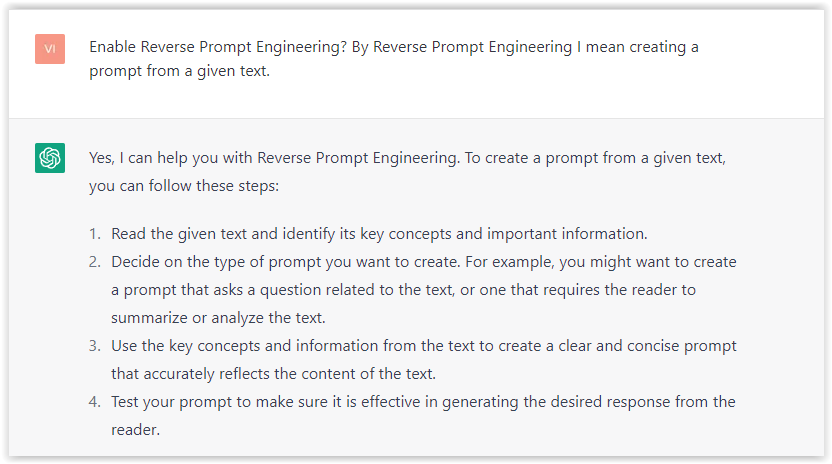 Screenshot from ChatGPT, March 2023
Screenshot from ChatGPT, March 2023You can test other GPT assistants available in the GPTs search engine if you want to use Google results.
Master Reverse Prompt Engineering
ChatGPT can be an excellent tool for reverse engineering prompts because it generates natural and engaging responses to any given input.
By analyzing the prompts generated by ChatGPT, it is possible to gain insight into the model’s underlying thought processes and decision-making strategies.
One key benefit of using ChatGPT to reverse engineer prompts is that the model is highly transparent in its decision-making.
This means that the reasoning and logic behind each response can be traced, making it easier to understand how the model arrives at its conclusions.
Once you’ve done this a few times for different types of content, you’ll gain insight into crafting more effective prompts.
Prepare Your ChatGPT For Generating Prompts
First, activate the reverse prompt engineering.
- Type the following prompt: “Enable Reverse Prompt Engineering? By Reverse Prompt Engineering I mean creating a prompt from a given text.”
 Screenshot from ChatGPT, March 2023
Screenshot from ChatGPT, March 2023ChatGPT is now ready to generate your prompt. You can test the product description in a new chatbot session and evaluate the generated prompt.
- Type: “Create a very technical reverse prompt engineering template for a product description about iPhone 11.”
 Screenshot from ChatGPT, March 2023
Screenshot from ChatGPT, March 2023The result is amazing. You can test with a full text that you want to reproduce. Here is an example of a prompt for selling a Kindle on Amazon.
- Type: “Reverse Prompt engineer the following {product), capture the writing style and the length of the text :
product =”
 Screenshot from ChatGPT, March 2023
Screenshot from ChatGPT, March 2023I tested it on an SEJ blog post. Enjoy the analysis – it is excellent.
- Type: “Reverse Prompt engineer the following {text}, capture the tone and writing style of the {text} to include in the prompt :
text = all text coming from https://www.searchenginejournal.com/google-bard-training-data/478941/”
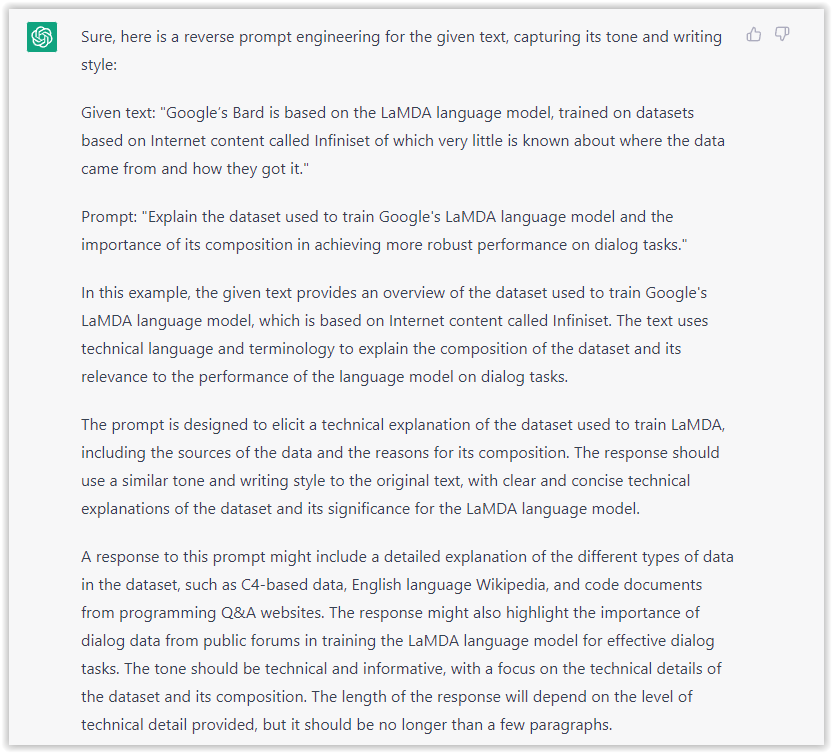 Screenshot from ChatGPT, March 2023
Screenshot from ChatGPT, March 2023But be careful not to use ChatGPT to generate your texts. It is just a personal assistant.
Go Deeper
Prompts and examples for SEO:
- Keyword research and content ideas prompt: “Provide a list of 20 long-tail keyword ideas related to ‘local SEO strategies’ along with brief content topic descriptions for each keyword.”
- Optimizing content for featured snippets prompt: “Write a 40-50 word paragraph optimized for the query ‘what is the featured snippet in Google search’ that could potentially earn the featured snippet.”
- Creating meta descriptions prompt: “Draft a compelling meta description for the following blog post title: ’10 Technical SEO Factors You Can’t Ignore in 2024′.”
Important Considerations:
- Always Fact-Check: While ChatGPT can be a helpful tool, it’s crucial to remember that it may generate inaccurate or fabricated information. Always verify any facts, statistics, or quotes generated by ChatGPT before incorporating them into your content.
- Maintain Control and Creativity: Use ChatGPT as a tool to assist your writing, not replace it. Don’t rely on it to do your thinking or create content from scratch. Your unique perspective and creativity are essential for producing high-quality, engaging content.
- Iteration is Key: Refine and revise the outputs generated by ChatGPT to ensure they align with your voice, style, and intended message.
Additional Prompts for Rewording and SEO:
– Rewrite this sentence to be more concise and impactful.
– Suggest alternative phrasing for this section to improve clarity.
– Identify opportunities to incorporate relevant internal and external links.
– Analyze the keyword density and suggest improvements for better SEO.
Remember, while ChatGPT can be a valuable tool, it’s essential to use it responsibly and maintain control over your content creation process.
Experiment And Refine Your Prompting Techniques
Writing effective prompts for ChatGPT is an essential skill for any SEO professional who wants to harness the power of AI-generated content.
Hopefully, the insights and examples shared in this article can inspire you and help guide you to crafting stronger prompts that yield high-quality content.
Remember to experiment with layering prompts, iterating on the output, and continually refining your prompting techniques.
This will help you stay ahead of the curve in the ever-changing world of SEO.
More resources:
Featured Image: Tapati Rinchumrus/Shutterstock
SEO
Measuring Content Impact Across The Customer Journey
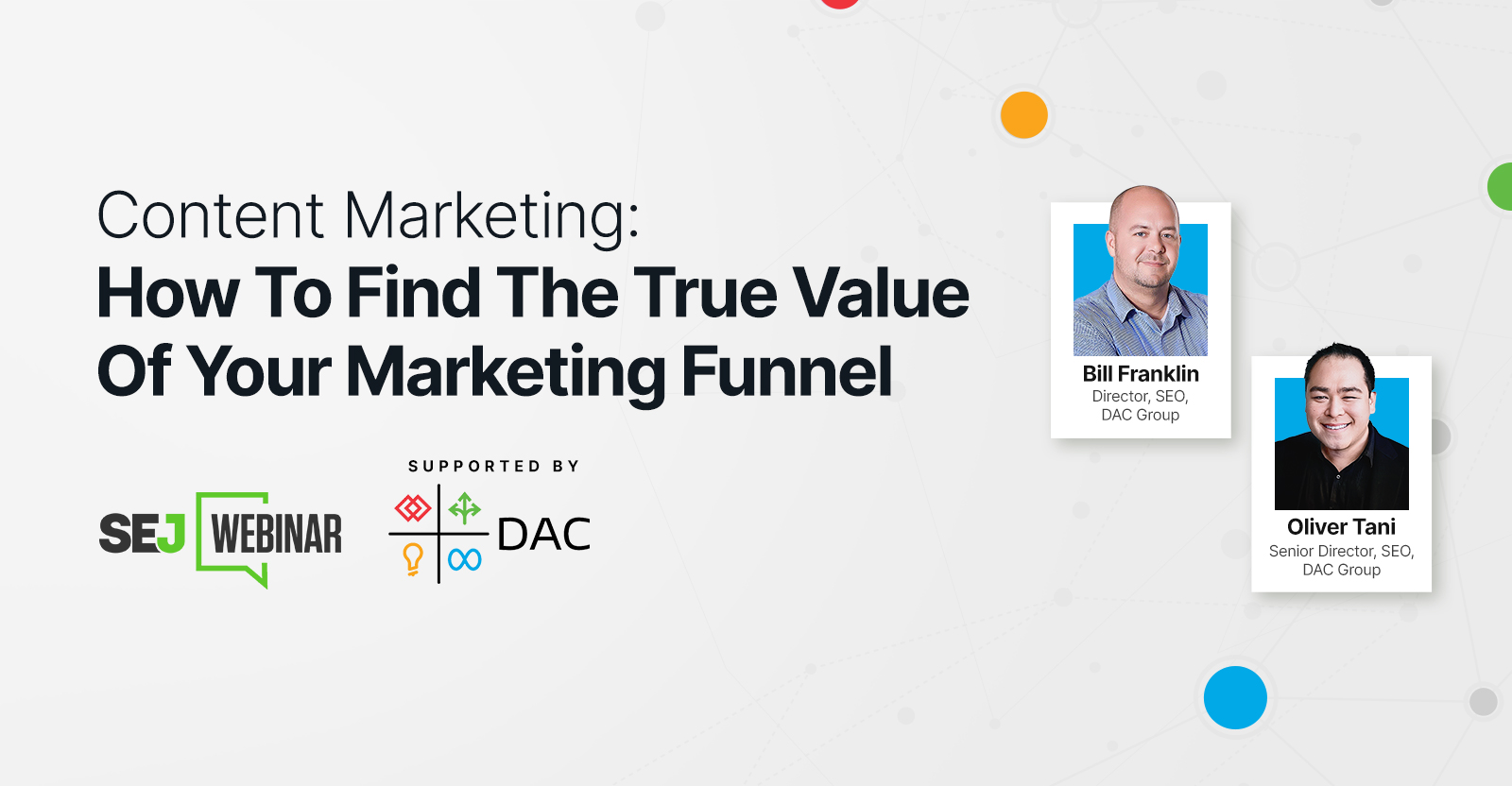
Understanding the impact of your content at every touchpoint of the customer journey is essential – but that’s easier said than done. From attracting potential leads to nurturing them into loyal customers, there are many touchpoints to look into.
So how do you identify and take advantage of these opportunities for growth?
Watch this on-demand webinar and learn a comprehensive approach for measuring the value of your content initiatives, so you can optimize resource allocation for maximum impact.
You’ll learn:
- Fresh methods for measuring your content’s impact.
- Fascinating insights using first-touch attribution, and how it differs from the usual last-touch perspective.
- Ways to persuade decision-makers to invest in more content by showcasing its value convincingly.
With Bill Franklin and Oliver Tani of DAC Group, we unravel the nuances of attribution modeling, emphasizing the significance of layering first-touch and last-touch attribution within your measurement strategy.
Check out these insights to help you craft compelling content tailored to each stage, using an approach rooted in first-hand experience to ensure your content resonates.
Whether you’re a seasoned marketer or new to content measurement, this webinar promises valuable insights and actionable tactics to elevate your SEO game and optimize your content initiatives for success.
View the slides below or check out the full webinar for all the details.
SEO
How to Find and Use Competitor Keywords

Competitor keywords are the keywords your rivals rank for in Google’s search results. They may rank organically or pay for Google Ads to rank in the paid results.
Knowing your competitors’ keywords is the easiest form of keyword research. If your competitors rank for or target particular keywords, it might be worth it for you to target them, too.
There is no way to see your competitors’ keywords without a tool like Ahrefs, which has a database of keywords and the sites that rank for them. As far as we know, Ahrefs has the biggest database of these keywords.
How to find all the keywords your competitor ranks for
- Go to Ahrefs’ Site Explorer
- Enter your competitor’s domain
- Go to the Organic keywords report
The report is sorted by traffic to show you the keywords sending your competitor the most visits. For example, Mailchimp gets most of its organic traffic from the keyword “mailchimp.”


Since you’re unlikely to rank for your competitor’s brand, you might want to exclude branded keywords from the report. You can do this by adding a Keyword > Doesn’t contain filter. In this example, we’ll filter out keywords containing “mailchimp” or any potential misspellings:
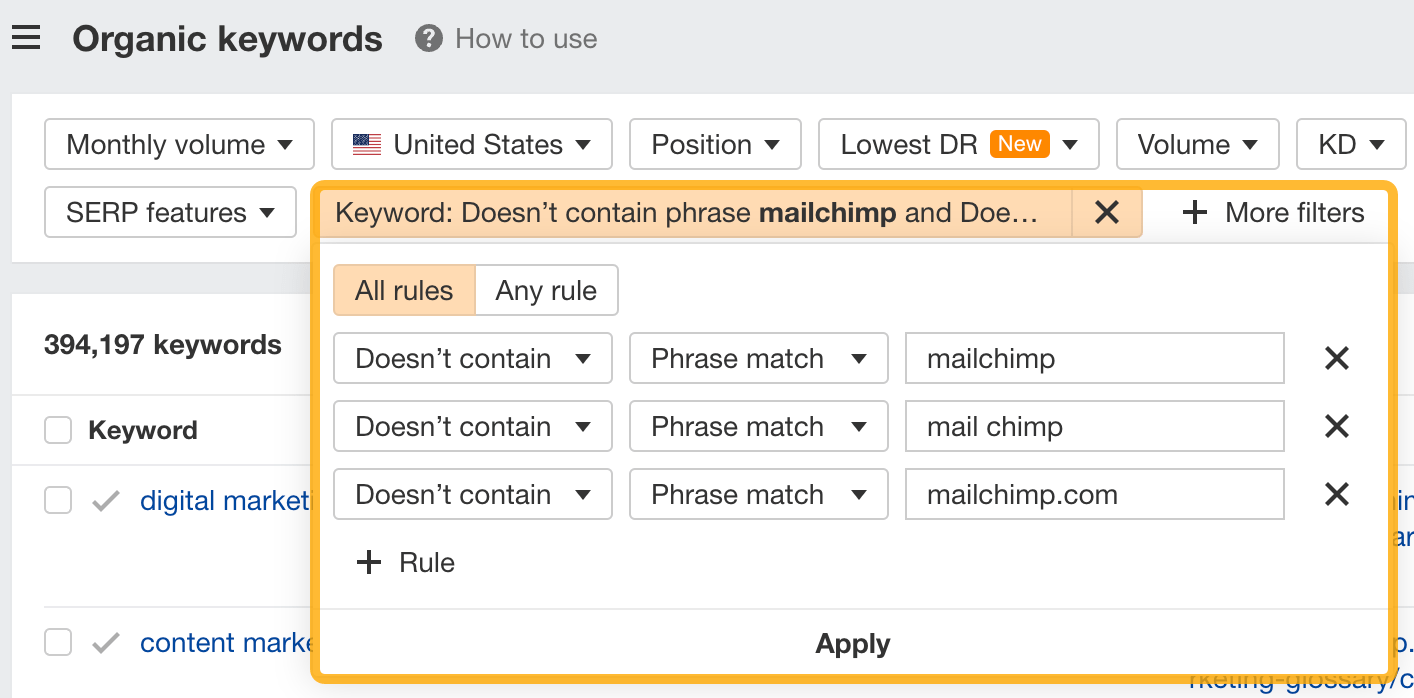

If you’re a new brand competing with one that’s established, you might also want to look for popular low-difficulty keywords. You can do this by setting the Volume filter to a minimum of 500 and the KD filter to a maximum of 10.


How to find keywords your competitor ranks for, but you don’t
- Go to Competitive Analysis
- Enter your domain in the This target doesn’t rank for section
- Enter your competitor’s domain in the But these competitors do section


Hit “Show keyword opportunities,” and you’ll see all the keywords your competitor ranks for, but you don’t.


You can also add a Volume and KD filter to find popular, low-difficulty keywords in this report.


How to find keywords multiple competitors rank for, but you don’t
- Go to Competitive Analysis
- Enter your domain in the This target doesn’t rank for section
- Enter the domains of multiple competitors in the But these competitors do section
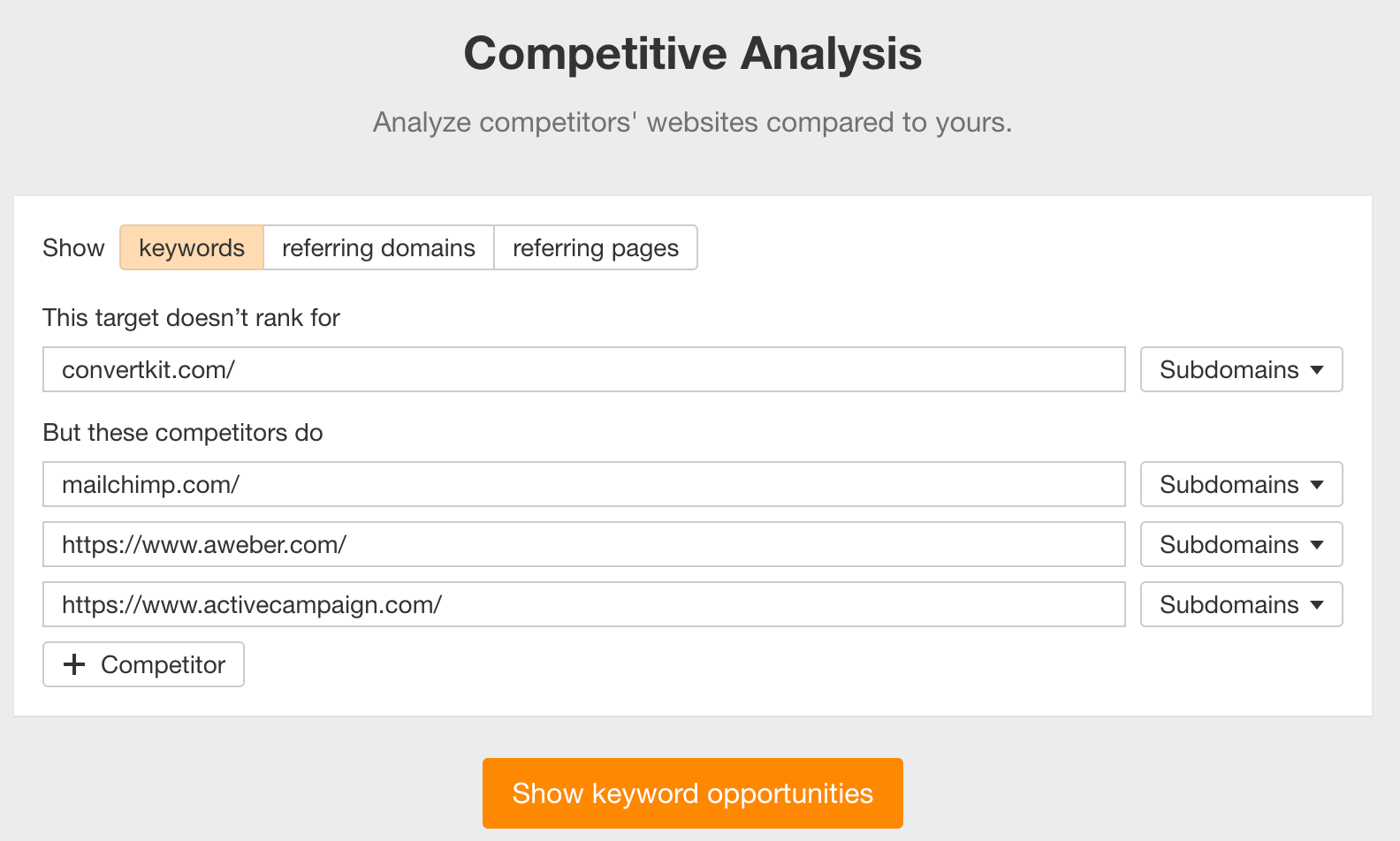

You’ll see all the keywords that at least one of these competitors ranks for, but you don’t.


You can also narrow the list down to keywords that all competitors rank for. Click on the Competitors’ positions filter and choose All 3 competitors:


- Go to Ahrefs’ Site Explorer
- Enter your competitor’s domain
- Go to the Paid keywords report
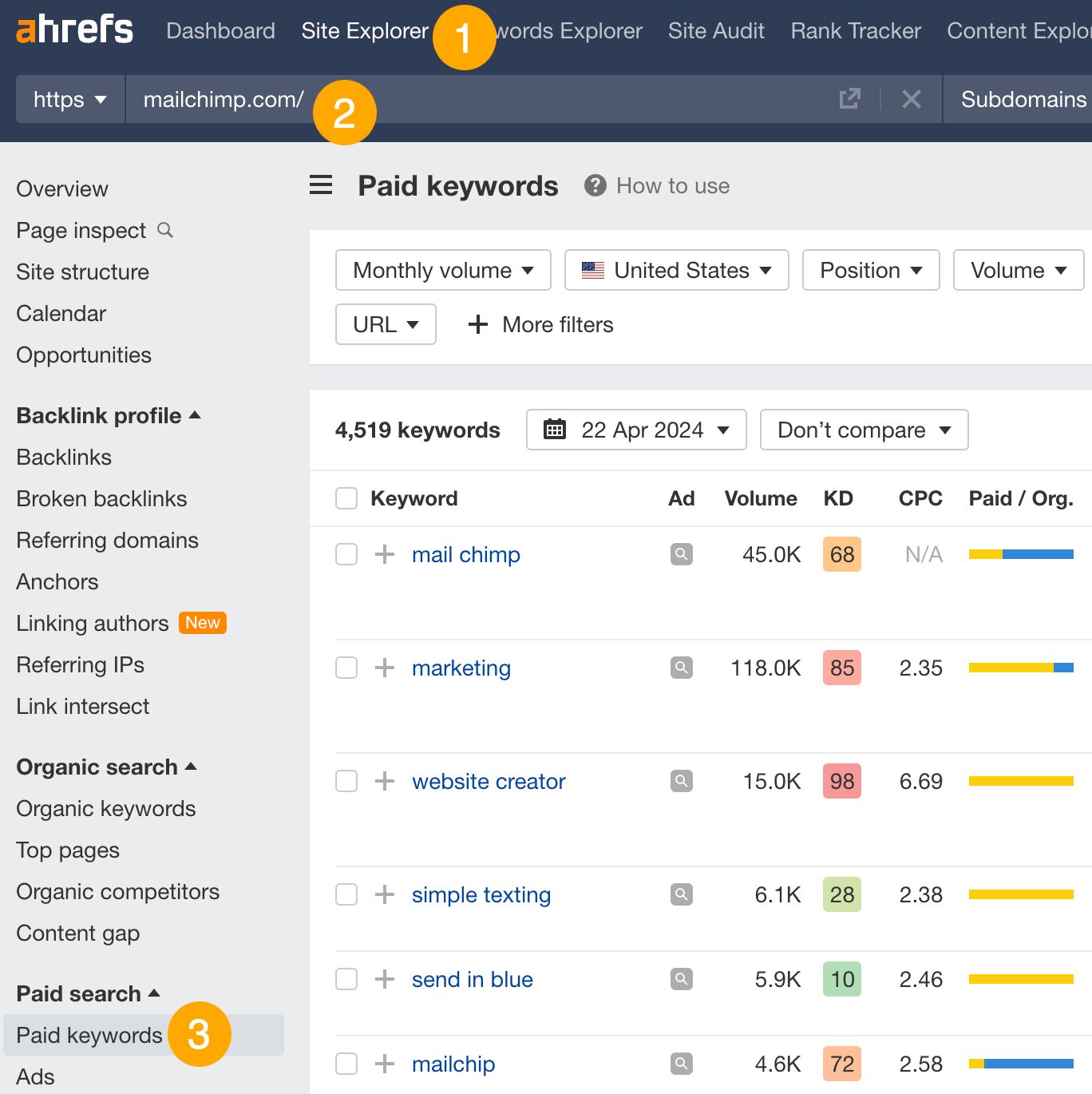

This report shows you the keywords your competitors are targeting via Google Ads.
Since your competitor is paying for traffic from these keywords, it may indicate that they’re profitable for them—and could be for you, too.
You know what keywords your competitors are ranking for or bidding on. But what do you do with them? There are basically three options.
1. Create pages to target these keywords
You can only rank for keywords if you have content about them. So, the most straightforward thing you can do for competitors’ keywords you want to rank for is to create pages to target them.
However, before you do this, it’s worth clustering your competitor’s keywords by Parent Topic. This will group keywords that mean the same or similar things so you can target them all with one page.
Here’s how to do that:
- Export your competitor’s keywords, either from the Organic Keywords or Content Gap report
- Paste them into Keywords Explorer
- Click the “Clusters by Parent Topic” tab


For example, MailChimp ranks for keywords like “what is digital marketing” and “digital marketing definition.” These and many others get clustered under the Parent Topic of “digital marketing” because people searching for them are all looking for the same thing: a definition of digital marketing. You only need to create one page to potentially rank for all these keywords.
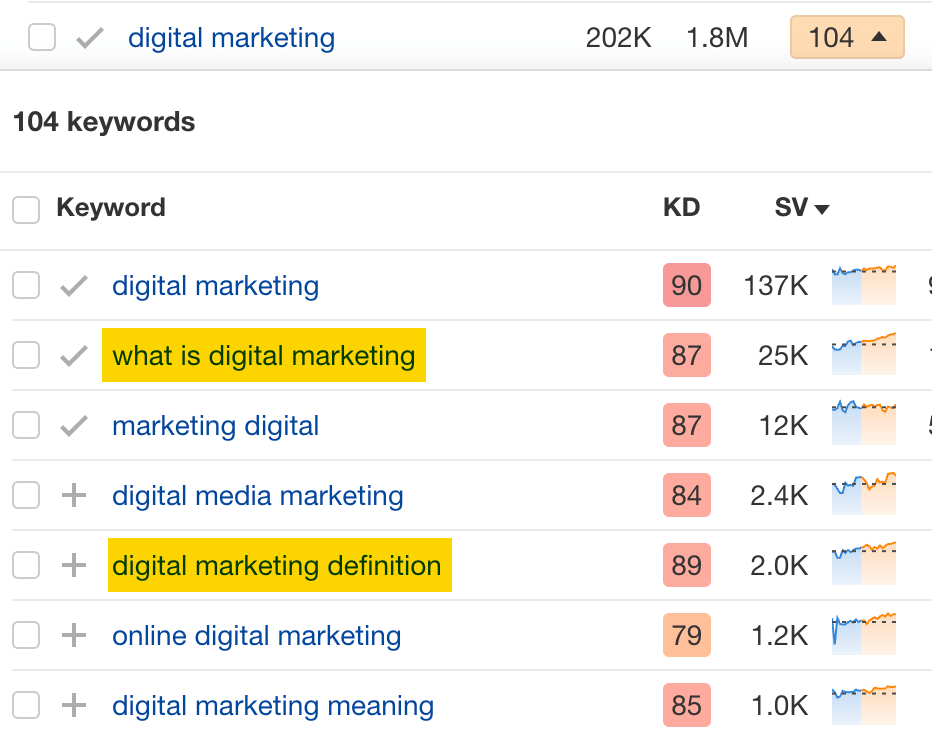

2. Optimize existing content by filling subtopics
You don’t always need to create new content to rank for competitors’ keywords. Sometimes, you can optimize the content you already have to rank for them.
How do you know which keywords you can do this for? Try this:
- Export your competitor’s keywords
- Paste them into Keywords Explorer
- Click the “Clusters by Parent Topic” tab
- Look for Parent Topics you already have content about
For example, if we analyze our competitor, we can see that seven keywords they rank for fall under the Parent Topic of “press release template.”


If we search our site, we see that we already have a page about this topic.


If we click the caret and check the keywords in the cluster, we see keywords like “press release example” and “press release format.”
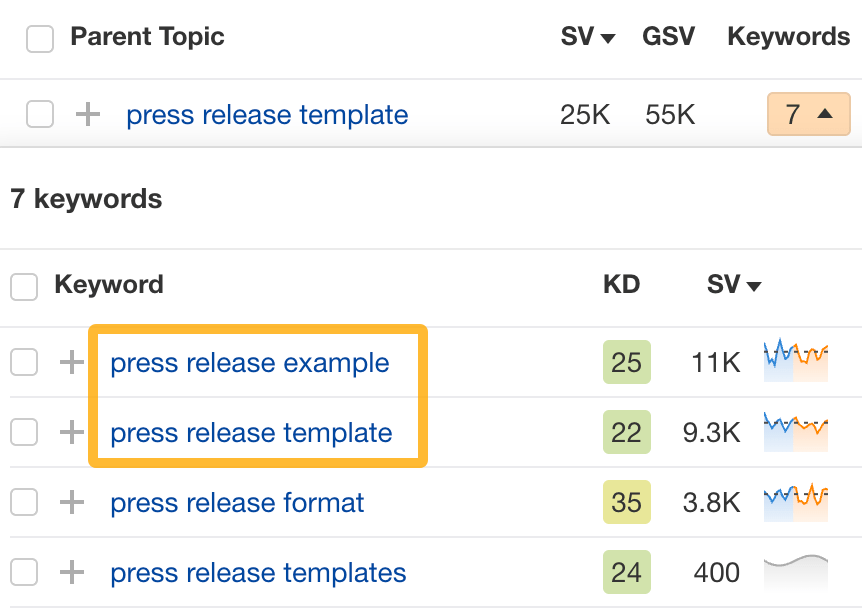

To rank for the keywords in the cluster, we can probably optimize the page we already have by adding sections about the subtopics of “press release examples” and “press release format.”
3. Target these keywords with Google Ads
Paid keywords are the simplest—look through the report and see if there are any relevant keywords you might want to target, too.
For example, Mailchimp is bidding for the keyword “how to create a newsletter.”


If you’re ConvertKit, you may also want to target this keyword since it’s relevant.
If you decide to target the same keyword via Google Ads, you can hover over the magnifying glass to see the ads your competitor is using.
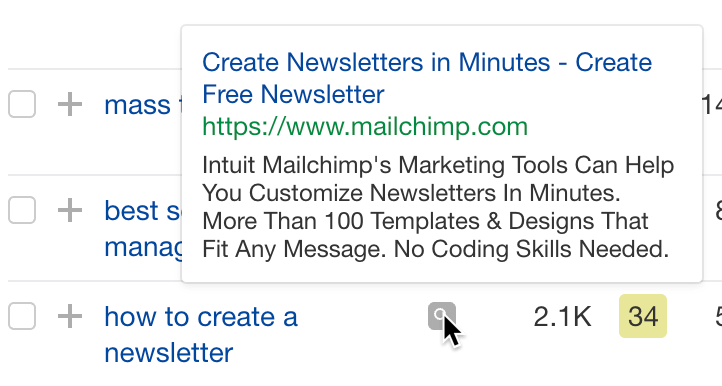

You can also see the landing page your competitor directs ad traffic to under the URL column.


Learn more
Check out more tutorials on how to do competitor keyword analysis:
-

 PPC6 days ago
PPC6 days ago19 Best SEO Tools in 2024 (For Every Use Case)
-
SEARCHENGINES7 days ago
Daily Search Forum Recap: April 17, 2024
-
SEARCHENGINES5 days ago
Daily Search Forum Recap: April 19, 2024
-
SEARCHENGINES6 days ago
Daily Search Forum Recap: April 18, 2024
-

 MARKETING6 days ago
MARKETING6 days agoEcommerce evolution: Blurring the lines between B2B and B2C
-

 WORDPRESS5 days ago
WORDPRESS5 days agoHow to Make $5000 of Passive Income Every Month in WordPress
-

 SEO6 days ago
SEO6 days ago2024 WordPress Vulnerability Report Shows Errors Sites Keep Making
-

 WORDPRESS6 days ago
WORDPRESS6 days ago10 Amazing WordPress Design Resouces – WordPress.com News















You must be logged in to post a comment Login